Stok Kangri
It is for a first time that I got a chance to climb higher than 20,000 feet. Fortunately, I could make it, but all I can say that it was a success only due to chance, and not by choice.
The expedition was almost on the verge of failure, and it was due to a combination of three factors – nature, logistics and partner. Also, there were innumerable instances, where decision making needed to be done, in a conflicting opinions’ environment. I call these situations
Decision Making Situations (DMS).
The summit was wonderful, but there were a lot of lessons learnt.
Stok Kangri is the highest mountain in the Leh region. There are many mountains higher than Stok Kangri, and this is usually called a “trekking peak”. It’s a different matter that it no longer carried that designation, due to the heavy snowfall this season. The trip from Sonamarg to Leh was an about 26 hours of travel on the Jammu and Kashmir Road Transport Corporation (JKRTC), and was by far one of the most interesting rides of my life. I call that long, tiring and eventful journey as the Pre-Expedition.
10th June, 2012 (End of long and tiring journey)
We reached Leh at around 4:30 pm, after an arduous journey from Sonamarg, which started the day before at 2:30 pm. It was one of the most interesting journeys of my life, and whosoever is interested in reading about it, can go here.
We were sitting in front of Mr. Dorje, who heads the travel company “Discover Ladakh”, with its office on Changspa road in Leh. After the initial discussion on the equipment rental which Om needed, we got on with the main discussion – departing for Stok village,
which is situated at the base of the mountain. There were clouds hovering over the entire city, and because we were so exhausted from the journey, we decided to take rest, and head for the village the next day. It was terribly cold in Leh, and after our final packing, we hit the bed for a much needed sleep, with firm plans of leaving the next day. Mr. Dorje also pointed to his sweater and his jacket saying that it is very rare that he is wearing these many layers in June, which usually has much higher temperatures. He said it had snowed heavily in the last few days, and the weather has been bad all along.
DMS 1 – should we go to Stok village on the same day as we reached Leh, as planned – No, we would go the next day. This decision was easy to make, with no conflict of interests.
11th June, 2012 (DMS Intensify)
We got up, to see dark clouds in the Stok valley, just like the previous day, and our moods dampened. Om was of the opinion that we should not even go and stay at the Stok village. Sitting in front of Mr. Dorje, he suggested that we take it easy that day too, and head out of Leh the next day, as there was no chance according to him, that we could go further than the village. At that moment, I was surprised to hear Om spell out a plan – he asked Mr. Dorje about a “Plan B”. He asked Mr. Dorje, if the weather doesn’t clear even the next day, would there be a chance that we could maybe head out of Leh, and do a small trek in the region. I wouldn’t say that he was wrong. We were just spending money staying at the hotel, and eating out in the town. Considering that we had about 1 week, a trek somewhere would have at least made us do some “activity” instead of just roaming around like tourists, which we were not interested in doing, at all. As much as I agreed with his idea, for the last 5 months, my mind was just focused on one thing – Stok Kangri, and I could not even think of doing anything else but to go and climb that mountain, even if it meant sitting it out at the base camp, in rain, for a clear weather window to come up. Mr. Dorje suggested a 3-day trek, which he called a “baby trek”, and a 5-day trek, which was an intermediate trek.
DMS 2 – Should we completely abandon the plan to climb Stok Kangri, and go instead for a trek in the Ladakhi Himalayan range? As the weather didn’t show any chance of opening up, Mr. Dorje suggested we go and take a walk around the city. So, we started walking towards Shanti Stupa, a Buddhist monument made by the Japanese. The road to the monument led from in front of our home stay. As we started going up on the road, I opened up my mind to Om by saying – “I think, we should not go for any trek. I and you have practiced for the last 5 months, and all I have been thinking about is to summit the mountain.” Om’s viewpoint was also not wrong, of doing “something” instead of “nothing”. It’s just that for me that “something” was “climbing Stok Kangri”, which was “everything”. There was no other plan that even cropped up in my mind. On the way to Shanti Stupa, I was able to convince Om of one thing – that we should at least to go the base camp, and wait it out for a clear weather window. I could see that reluctance in his agreement, and I hated to force it down his throat, but we had come all this way to do this, and for me, there was absolutely no other alternative. After the customary photos at the Shanti Stupa, we walked across small nearby villages, to go and climb a couple of hundred feet to the fort in Leh, after which we took the trail to the Leh Palace.
![Leh s Royal Family s Palace]()
The palace was almost going to get shut down for the day, so instead of seeing it from inside, we climbed down to the market. A meal of Thukpa and momos in a typical Tibetan restaurant, and we were walking back towards our hotel. The next day, we were pretty much confirmed about leaving for Stok village.
12th June, 2012 (Started from Leh, finally!)
Mr. Dorje introduced me to Tashi Norbu,
a guy from Zhanskar, who had agreed to accompany us for 3-4 days on the trek. It was during the final packing in Pune, that we had realized that although we were able to carry a weight of about 28 kg on our back, we were just out of space, when it came to carrying food, the utensils to cook it in, and the stove. So,
DMS 3 actually occurred in Pune, when we both mutually had decided to hire a helper / porter, who would help us with the load. Tashi was supposed to come with us all the way to base camp, dump the load, and head back down to Leh, as he had to go on another trek. So, he loaded his pack with the food, our tent, and his sleeping bag. Apart from this, his set of sandals, socks, and a poncho got shoved in my pack, as he didn’t have space. A taxi was called at the office, and we loaded the packs on to it. As we headed to the village, we realized that the weather was indeed clearing up, and we stood a good chance of not getting soaked in rain, while on our way to Changma-Chen, a campsite before Mankarmo.
![Looking Back]()
Mankarmo is the first campsite, which people usually camp at, but Om was not comfortable in hiking all the way to Mankarmo, with the loaded pack on his back. He had already seen this route, when he attempted Stok Kangri four years ago, and he exactly knew how much effort went into it. I think, it was good as well as bad. Good, as he knew what to expect on the route, and bad because he was psychologically giving in, to the fact that he was carrying a loaded backpack on a route, which he knew was not very easy, i.e. it had it share of ups and downs. We left for Changa-Chen at around 12:45 pm in the morning, and we reached the campsite at 3. We did good, considering that we took a little more than the 2 hours people take to reach this campsite. As soon as we reached the campsite, we made camp. As soon as the tent was up, we started pumping the stove and had tea, followed by soup and dinner, which consisted of pre-made Upma, which just had to be cooked in boiling water.
![tea]()
Tashi was used to eating rice for his meals, so he probably didn’t like the Upma, but ate it without any complaint. We both were too full from the tea and soup, so we had a round of Bournvita along with biscuits. This campsite also had a small make-shift restaurant, which is run by the people of Stok village, and which serves basic things like rice and curry (dal), Maggi (ready to eat noodles), biscuits, etc. We all were in our sleeping bags by 9. Right from the time we reached our campsite, I was constantly asking Om whether he was feeling alright. Apart from the high level of perspiration that his body experiences, which makes him tired, he said he was OK. We made sure, we had lots of fluids, and he gets rejuvenated before we hit the bed.
13th June, 2012 (To go or not to go)
Om got up saying that he didn’t have a good night’s sleep, and he was cold the entire night. He has a good Lafuma down sleeping bag, which was rated to -1 degree centigrade, but I guess, it didn’t make the cut. Also, he said, he had a very bad dream about his son, which made him a little nervous.
We broke camp, and started towards Mankarmo,
our second campsite. One of the reasons that we broke the journey to Mankarmo (which usually people do in a day from Stok village) was to get acclimatized properly. Although we had travelled across Zozila pass, and had slept a night at Kargil, Om wanted to be doubly sure that we don’t get altitude sickness, which could have easily killed the expedition.
Om was a little tensed about an initial “uphill” walk, which according to him was quite tough, from his recollection of his attempt 4 years ago. At that time, they all had taken the Zhingchen – Rumbak – Stokla route to Mankarmo, and had come down to Stok village directly, on their way down. So, he remembered the route clearly. We headed out of Changma-Chen and within no time, we climbed up to the pass which Om was talking about. I even remember telling Om that the climb was “actually” not as hard as he remembered from 4 years ago. A downhill from the pass,
and we were skirting along the river, with beautiful vistas in front of us, before we reached the “crossing”.
This is the place where the route from StokLa comes and joins the direct route, and goes towards Mankarmo, a route which Om had taken the last time he had come here. It is indeed a pretty big confluence of two streams coming down from different valleys. But, due to the heavy snowfall this year, the rivers were still not that big, and there were small glaciers, which needed to be crossed. Nothing serious, but when you hear the water running beneath the glacier under your feet, you wonder what will happen if your snow under your foot caves in.
Within an hour and a half, we reached a campsite, and when we were going to unload our backpacks to set up camp, we saw Tashi walk in a different direction, pointing us to join him in that direction. This campsite was newly established, and both Om and I thought it to be Mankarmo.
Our arrival at the campsite infused a new enthusiasm in us, and Om was excited to have made it to Mankarmo in less than two hours. Our enthusiasm was short-lived, and we started for the actual camp.
At Mankarmo, we were welcomed by the Norbu family head, who was looking after the make-shift restaurant there. His son had gone to the next camp, called the base camp, to fetch the horses, which had gone with the previous team. It is from the base camp that you take a summit attempt.
Weather at Mankarmo camp was not so good. At higher altitudes, we could see dark clouds hovering above the summit. As soon as we set up camp, we see a figure walking towards us, from the base camp. He was a French national, who had climbed in the Alps as well as Nepal Himalayas. He looked so exhausted that he first had to rest, take in deep breaths, and have a bottle of coke. It is only after these three things that he spoke – “It’s impossible. You have knee and sometimes waist deep snow, and it takes a lot of effort to break trail and climb. You really need to have strong legs, if you want to summit. This incident was followed by another team of two French, who looked pros, but could not summit.
![Three of us]()
I feel, Information can be both good and bad. This information was bad. Having seen the French guys, Om was in a double mind, whether to go up to the base camp or not. The conversations with them even worked on my psyche, and I told myself – “if it has snowed so heavily and if these two guys could not make it, then there is no way in this world that we would be able to go for it.” Here is where
nature played a critical role in us deciding whether to go further or to turn back.
That day, there were three teams at Mankarmo. One was us. Second was a group of 4 Brits, one Spaniard and one Canadian. They had struck a good deal with one of the trekking agencies in Leh, and had climbed up straight from Stok village to Mankarmo, albeit with day packs on their backs. The third team was an Indian group, which had started from Rhumbak, climbed and descended StokLa and had walked up to Mankarmo.
![On the way 3]()
![Beautiful Morning]()
Some of them were so tired, that they reached the campsite at around 6 pm in the evening. I later learnt that out of the 7-8 people in their group, there were 2-3 first timers. They all had come through an agency from Mumbai, with their leader as Prateek Desai, who had summitted Stok Kangri 4 times. We felt that he should not have brought the first timers on a Stok Kangri climb. All three teams had planned on advancing to the base camp the next day. Having reached pretty early, we had rested enough. The Brits’ team seemed strong to make it to the base camp the next day. The Indian team was a little tired, but they had no choice, as they had their return flights booked for the 17th. So, that meant, they would go to the base camp the next day, and immediately in the night – go for the summit. Even the Brits had the same plan. In the evening, inside the tent, Om said, “If those French guys could not do it, and their guides also couldn’t take them up there till the summit, then we are not even from this region. In other words, is it even worth going up to the base camp?” That question took us to
DMS 4 – would we go up or not? After a little discussion, we agreed on a “Yes”. We both would go up and set up camp. Tashi would go ahead, dump our stuff at the base camp, and run down to Stok village. We would slowly advance, and set up camp.
DMS 5 – Because we didn’t have any guide, and we had planned on attempting the summit on our own, would we go for the summit with these two groups on the same night when we reach base camp? Om decided that he would just wait at the base camp, and I would attempt the summit with the two groups going up. It was just comforting to be with people, instead of being all alone on the mountain, which can get a little risky. So, with the final thought of attempting the summit the next night, we dozed off.
14th June, 2012 – (Reverse Gear)
We woke up in the morning to heavy snowfall. Our tents were all white, and it was white on the ground everywhere. We came out of the tent, and saw the weather up near the base camp go from bad to worse. And then, all of a sudden, the snowfall stopped.
It wasn’t exactly sunny, but we did get some time to wrap up our stuff. As soon as we were all ready to leave, with packs on our back, snowfall started again! And, this time, it was so heavy that we faced
DMS – 6 – Should we be even going up to the base camp in this weather? Tashi, our porter was all gung-ho about going up, dumping our stuff, and heading back home to Leh. He said that the snowfall would stop, and everything would clear in no time. The Brits had decided to go up, even in the heavy snowfall, with all their paraphernalia.
We thought they were pretty brave for 18-20 year old college lads, who had no previous climbing experience. In my heart of hearts, I wished, I could go with them. The Indian team leader said – “There is absolutely no way that anybody could even attempt the summit in this weather. We all are going to go up, take some pictures, and come back down to Mankarmo. Our kitchen tent, staff and porters are not coming with us.” His statements were so firm that it made us yield as well. Information from the French, the Indian team’s decision, heavy snowfall, no summits till date, contributed to Om’s reluctance to carry forward, and I agreed with him.
Strange how deeply a decision affects you. In my heart of hearts, I knew that – although everything – and I mean everything looked bleak – still, I would have pushed up to the base camp, and waited in my tent.
This was because I knew, we had time. We had our flight on the 19th, and 5 days is a lot of time for conditions t change drastically in the mountains.
Om and I decided to stick around at Mankarmo, and if and when the weather cleared, we would also go up to the base camp, take pretty pictures, and come back and stay at Mankarmo. The next day, we wind up everything, we head back down, pre-pone our tickets, and reach Pune before the 16th of June, which was my son’s birthday. With this decision, we let Tashi leave for Leh, with all the equipment that we had rented (Ice Ax, Gaiters, Crampons, Harness and climbing boots) for Om. As we sipped on tea, the weather cleared, and it became as bright as ever. The Indian team had left, and their cooks and porters were winding up stuff.
![Indian Team]()
I asked them – aren’t you guys staying here for the team to return from base camp? No was his answer. They had been told to wind up everything, and head to the base camp, as the Indian team was going to attempt the summit that night. I was shocked to my core! In the end, we were the only ones, who had decided to stay at Mankarmo. We had returned Om’s gear, Tashi (who carried the food and our tent) was gone, we had only 1 tent, and food for 2 days. I could have easily gone up stayed at the base camp, and taken the summit attempt with the two teams.
But now, we were both stuck at Mankarmo, and I felt very sad. I definitely was not going to leave my partner and tell him to head back down, while I attempt the summit. It would be highly unfair and selfish on my part, I thought.
So, I stuck with the plan – we both go up, take pictures, come down, stay the night, and head back to Leh – basically, abandon the climb, mainly due to weather reasons. Here, logistics comes into picture. Had we had a team of porters, one more tent, one guide to go with Om, and one who could come with me, we could have split and gone in opposite directions. But we were just two, who had planned on going entirely self-supported, and summitting the mountain with Om’s knowledge of the route.
We headed up to the base camp. I carried the day pack with chocolates, Frooti, cheese and some dry fruits for our trek up and back.
In the middle of the hike up, Om got extremely tired, and told me that he would like to head back. He knew exactly where we were, and the base camp was only half an hour away, but he was not interested in carrying on.
![Diverging Paths]() Om went back from here.
Om went back from here.We split the packed eatables, and I told him to wait for me to return. I reached the base camp, and saw the trail that goes up to the ridge, beyond which the snow starts. After the ridge,
there is a long traverse of about one and a half hour, which takes you to the advance base camp. It is no longer permitted to camp at this site.
Once you reach the advance base camp, you walk on the glacier and enter the “C” section of Stok Kangri.
In the month of July and August, one usually climbs up the ridge, and traverses on the ridge up to the summit. But now, with the heavy snow, it was inevitable to take the direct route up the mountain, which meant climbing on about 50 degree slope. I made it to the base camp in about 2 hours, and walked up to the ridge in about 28 minutes, without any headache and dizzy feeling. This just told me that I could’ve just attempted the peak, as I felt physically and mentally prepared for the attempt. But, the two teams were going to attempt that very night, and I had to go back to Mankarmo.
With a sad feeling and a heavy heart, I started back for Mankarmo. As fate would have had it, a guide was going to the base camp, to help the Indian team in attempting the summit. He had met Om at Mankarmo, and knew about our situation. So, after a brief chat, he offered – “If you have the capacity to walk, I will surely take you to the summit.” It is impossible to state how much enthusiasm this statement infused inside me. I knew that I could walk; in fact I had trained so hard for this expedition that I was ready to give my best for the summit attempt.
My mind was in a state of confusion all the way down to Mankarmo. Time for
DMS – 7 – Should I tell Om of meeting with this guide? Can I convince him to come up with me to the base camp the next day, and let me go for the summit? Would he agree or would he press for both of us to go down? With these thoughts racing through my mind, I met Om, and told him of this chance encounter. The decision to split ways was easy. I tried my level best to persuade him to come up to the base camp with me the next day, but he had pretty much made up his mind to go back to Leh. One of the reasons that Om got tired while going to the base camp was that we had not had breakfast. I was sure that the next day, with a good breakfast, he would easily make it. Whether or not I make the summit, its always great to see somebody you know at the campsite, when you return. I tried to tell Om that I would like him to be with me at the base camp. But, it was tough to change his mind. Mentally, he was already in Leh. The restaurant owner at Mankarmo – Jayo (who studied in Nagpur, a city in my state) was also a little excited that I would be at least attempting the summit. He didn’t like the idea of both of us returning back from Mankarmo, and not attempting the summit at all. He was busy painting and decorating his restaurant premises, and he wrote a quote on a stone slab, and told me – this is for you.
![Inspirational Quote]()
15th June, 2012 – (Going solo, physically and psychologically)
Leaving one’s partner in the mountain is not the best thing to do, and one should not do it.
DMS – 8 – Should I go to the base camp, and attempt the summit or should I go ahead with Om to Leh, as planned? The conflict in my mind was raging, and a conversation with Om helped me take a decision faster. He was very supportive of me going for the summit attempt, and told me that he didn’t think, he would be able to make it even to the base camp, lest the summit.
I would have loved for him to at least get a feel for the snow conditions, and come up to the advance base camp or the glacier. That way, he would have got a good feel for the equipment that was rented, and would have prepared him for some future possible climbs.
As Tashi had left, I was left with two options – to carry the gear, food and the tent or look for a horse who could take my stuff up. Luckily, I found one guy, who was ready to take my backpack, and my tent, as he had a spare horse. So, I was at the base camp at around 2:30 pm. The Indian team had aborted the summit bid, and was packing for their return journey. The Brits had gone up for the summit, and had not yet returned. The Canadian girl, Alex, had not gone with the 4 guys, as she felt sick and uneasy in the morning when they left.
![Camp at BC]()
The Brits returned pretty late, but made the summit. It was the first summit of the season. I thought, I could’ve been a part of their success story, had I camped the earlier night at the base camp. The guide that had agreed to come with me started acting pricey. He said, it snowed last night, so the fees for him to take me would be a little higher. He knew for a fact that it was after discussing with him that I had taken the big decision to not go to Leh, and attempt the summit. In the end, we decided on an average of his asking price and my paying price. He was acting as if he was my client. I agree that he was not in the helper / cook / porter category, but it was me who was cooking meals for him, making tea for him. I had my stove, and I didn’t have my own cook, so I could not tell him to just go cook for himself. The afternoon lunch was a pre-mixed rice preparation, which he didn’t like much. In the evening, I was going to cook Upma for him, which he declined. So, I offered him porridge. After a bowl of porridge, he said, its too sweet, and would like to have something non-sweet. To our surprise, the kitchen staff of the American couple who had come, agreed to serve him dal-rice, which excited him.
With all gear, summit attempt food and water split and sorted, I slid inside my sleeping bag at 6 pm, with an agreement that we would wake up at 10:30, I would prepare soup for both of us, have it, and then leave for the summit at 11.
16th June, 2012 – (Alone, on the summit)
An extremely cold wave woke me up abruptly. As I saw my guide (Santosh) sleeping besides me, I was horrified to see the tent door open. Wide open! I never realized when Santosh came inside the tent, and I was even more surprised to see how one could just leave the door open, when it was 5 to 10 degrees below 0 outside? I looked at my watch – 11 pm. And, I woke him up stating that it was 11, and we should be heading out as soon as possible. He said, it was not a big deal, and I should start getting ready. While putting on my outer shell, I noticed that I had seen the time with blurry eyes, and it was not 11, but 12. 10 minutes had passed, and it was 10 past 12. We were an hour late already, and we needed to hurry.
The routine followed – getting out of the tent in biting cold, and putting on boots, gaiters, gloves harness, clipping on the carabiner, carrying the crampons, all in the headlamp’s light. We hit the trail at around 12:45 am, and were on the ridge at 1:25 am.
This is always the worst time for me in the climb – to pull off your gloves, and put on the crampons. We did the routine, and we were on our way towards advance base camp. At the advance base camp, I got the shock of my life – when Santosh said that he had forgotten his glacier goggles at the base camp! How could one forget such an important piece of equipment, that too, when the entire climb is on snow?
DMS – 9 – Should I tell him to go back to the camp, and get his goggles? Should I continue the climb with him? Should I just go back with him to the camp, and slide back in the sleeping bag? Should I just tell him to go back, and I continue on my own? With tons of questions in my mind, I waited for his reaction. He simply said – It’s OK. Let’s just continue. I was left wondering, how in the world is he going to climb without sunglasses, when the glacier could actually make him blind? One at 4 am, and then at 5:15 am, we took a break. After gulping down our share of frooti, chocolates and cheese, we headed for the climb ahead of us. We could see that the snow was fresh, knee deep and sometimes waist deep on the climb up.
About an hour later, all of a sudden, Santosh made a remark – “If we can’t summit before 8 am, then it is not going to happen.” It must have been 6 am, and I was wondering as to why he would make such a comment. And, then came his toilet time. He told me to continue climbing, while he took a dump, after which he would join me. I continued, and about 100 feet up, I saw him all done, and sitting on his backpack. I called his name thrice, to which he just waved his hand. Unable to understand,
DMS – 10 cropped up – Should I climb down 100 feet, and ask if he was OK? Should I continue, or should I wait for him to climb up and join me? I listened to my gut feeling, and continued breaking trail in the soft snow. It was extremely tiring, when I would step up 1 foot, and slide down 2 feet, just due to the softness of the snow. Also, whenever the snow-covered-rock section came up, my foot used to go thigh-deep.
I could see the ridge up there,
and I was just curious to know how far the summit was, from that ridge. I sensed it would not be that far.
Out of the blue, Santosh calls me from below, waves, and says – “You are not going to make it. Come back.” I just waved at him and told him to wait, while I see how far it is beyond the ridge that I saw.
I climbed on, only to realize that the ridge I was anticipating wasn’t there. In fact, the last point I saw was not even half way. This is when I asked myself –
DMS – 11 – Should I go for the summit? Should I return back? Should I just peep beyond the ridge, and see how far the summit was, from there? I felt good physically, I was not tired at all, no dizziness, no cramps, nothing. The weather was clear, and possibly, the summit could be just round the corner (i.e. beyond the ridge). I told myself to continue, but with some discipline. By discipline, I meant – spotting a nearer goal – a rock outcrop or a lumped-up-snow ball, and slowly get there – 10 steps, followed by 10 deep breaths. Once I reached the goal, I spotted another one 50-60 feet above – 10 steps / 10 breaths. And the loop seemed to continue indefinitely. By now, I was determined to go for the summit, and this was for a couple of reasons:
- I had trained really hard for this, for a long time, and that too, at sea-level. I wanted to see if training at sea-level could put me on the summit of a Himalayan peak.
- It was the 16th of June, and it was my son’s birthday.
Last year, I had summitted Kshitidhar on my sister’s birthday, so I wanted to do this one on my son’s birthday.
- If I summit, I would be the first Indian to summit the mountain this year, which is kind of a rare distinction.
- I really wanted to break the 20K limit / ceiling, preparing myself for higher climbs in the future, and this was the best chance.
Getting that plastic-wrapped-sticky-straw out, piercing the frooti and drinking it, with 2 layers of gloves on, can be one of the most frustrating experiences in this world. Also, peeling off two layers of a Cadbury, and breaking it to get the required energy is a similar one. I took a break, had some chocolate, 1 frooti, and headed on with the climb.
There was a rock patch at the end, beyond which I could not see anything. Did I see prayer flags? No. I slowly climbed up to the rock patch. I could see another rock patch on the far right. Did I see prayer flags? No. Looking at the mountain from Leh, I knew that there is a huge cornice that had formed on the summit, due to the heavy winds and recent snow. Om had told me that it won’t be possible to go to the real summit, but even if you see the prayer flags (which are about 5-10 feet from the summit), you should be OK. Also, the previous group of Brits had seen the prayer flags and had returned. Their guide also had warned me not to go on to the cornice. Hence, my desperation for the prayer flags. T my dismay, there were no flags even on the rocks on the far right. I walked past both these patches, and after a 5 minute walk on the same level – I was in front of the prayer flags, which denoted the summit of Stok Kangri.
![Summit]()
![(Partially) Me, on the Summit of Stok Kangri]()
By this time, I had never even looked around, as to how the view was. Now, the entire range lay bare, in front of my eyes. Awesome weather, clouds moving across gently, casting shadows on the snow-capped peaks, and then moving away, created a movie-like scenario. It looked like a scene right out of Discovery or National Geographic channel.
The sunlight and clouds were, as if, playing with each other, in perfect harmony, and I can easily say that I got a taste of heaven. All of a sudden, a giant white cloud approached the summit, and I took the decision to eat something on the way down, instead of, on the summit. The cloud also completely squashed my would-be attempts to take pictures from my DSLR, which I had hauled all the way to the summit. I took out my small Canon, took a few pictures quickly, took a small video, gulped down a few sips of water, and I was on my way down from the summit.
The Brits had slid down most of the slope. I am not very comfortable in sliding down a 50 degree slope, even though there are less chances of getting hurt (of course one should know how to arrest oneself, should a situation arise).
A very slow climb down, with heels digging in, actually drained me out. In small patches, I slid down the slope, and at certain places, I went thigh deep in snow, when I had to carefully extract myself. I didn’t expect Santosh to be there at the glacier at all, as by now, if he would’ve stayed, he would’ve gone blind.
I had to take a long break at the bottom of the slope, to rejuvenate myself. After the breaks, I again had to make short-term goals. If I would’ve thought of reaching base camp in one go, it would have been impossible. So it was – that turn, that climb, that slope, advance base camp, middle of the traverse, end of the traverse, ridge, and finally – the base camp. Slowly and steadily, I achieved the shorter goals, and reached the advance base camp. This was when I took another long break, munched on the left over cheese, chocolate and water. Santosh had given me a fistful of almonds, which still stayed on in my pocket. They helped a lot.
Santosh had gone back to the base camp, eaten a good lunch, had taken his goggles, and he met me in the middle of the traverse. He offered me some water.
I just asked him one question – Looking at the day’s events, do you think that the fee you have charged, is justified? Or should you be returning back some of it to me? He flatly disagreed, by saying that he doesn’t owe me anything. I didn’t speak anything further. He offered to carry my pack, to which I declined.
The traverse ended, and I was at the base camp at around 4:30 pm in the evening. The cook from the American couple’s (Keith and Laura from Montana) team offered me a cup of hot tea and some biscuits. Next few memorable events:
- The cook invited me to have dinner with them, which saved me the effort of pumping my Whisperlite.
- The sleep after the summit, no need to say, was as sweet as ever.
- I got up at 7. Keith and Laura had left for the summit at midnight. They were back to the base camp at 9:30 am! That is when I realized that both of them have about 20 years of mountaineering experience, and I am sure Stok was a cakewalk for them.
- Walking down from base camp to Stok village the next day, with my pack and tent on a horse.
- Meeting Jayo at his home in the village, and thanking him to believe in me, which led me to believe in myself.
- A hearty dinner of mutton burger (closest that comes to a greasy-and-thick-hamburger), followed by mutton momos, while watching Greece vs. Russia at the EuroCup 2012.
- A hot-water bath after a week, and the sleep that followed.
![Mr. Dorje]() Celebrating with Mr. Dorje. Sheldan Guest House (where I stayed) is seen behind.
Celebrating with Mr. Dorje. Sheldan Guest House (where I stayed) is seen behind.Lessons for me, for the next expedition
- Om had cycled the entire 475 km Manali – Leh route last year, which means he has strong legs. He was a great partner too, who was giving his best, in situations he had never been before. But, a partner who is equally passionate about climbing would have been much better. Om wanted to have a taste of snow, and he saw much more than he expected.
- Plan out the expedition with a guide, porters and mules – the works. It was funny to see Keith and Laura enjoying the services of a guided company, while we Indians were doing everything ourselves (I was trying to imitate the US-style climbing conditions; without any of the above mentioned support – I feel it is how an expedition should be planned, and done). But, sometimes, you do feel the difference. Especially, if I would have had to cook my tea, my dinner after a 15 hour climb.
- Don’t judge your own capability by comparing it with others. Others couldn’t do something, doesn’t mean, you can’t do it. Everybody is made different by god. And certainly wired differently in their minds.
- Respect nature, but don’t let it intimidate you. You better know your point of return, in case of an emergency.


















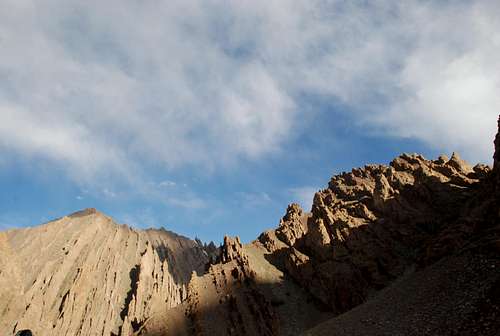







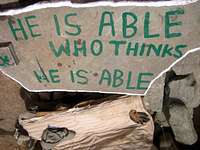
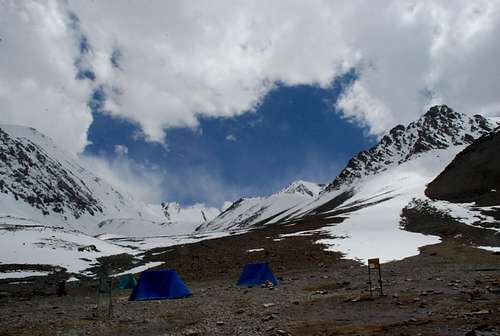



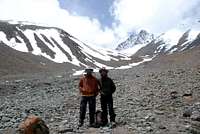











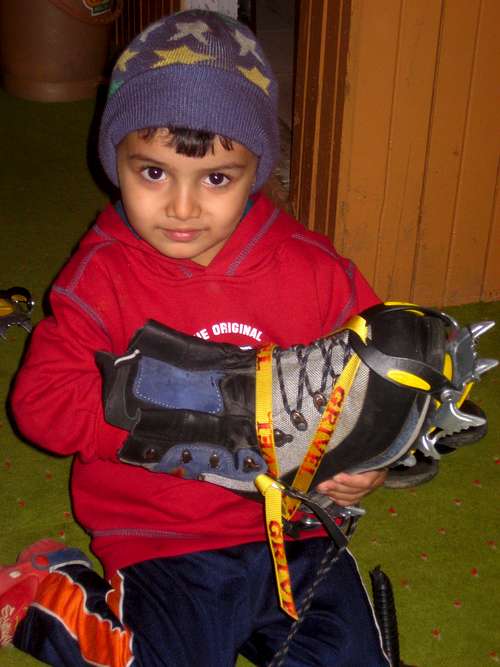


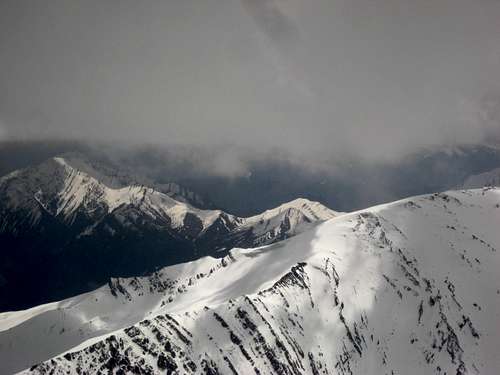

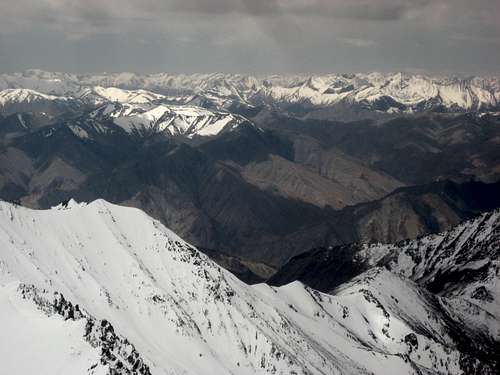



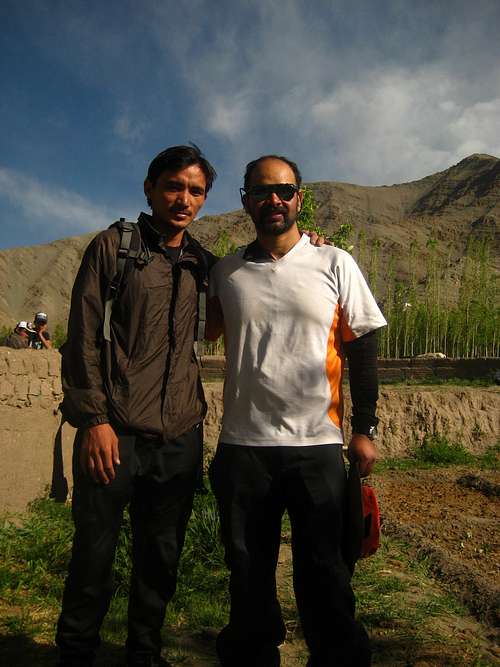




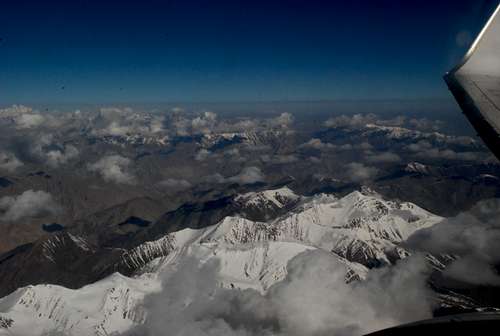




Comments
Post a Comment